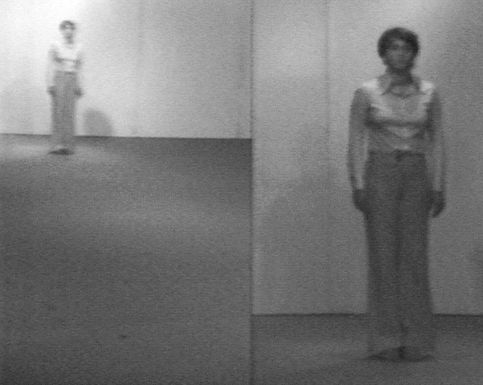Raumsehen und Raumhören

VALIE EXPORT
Raumsehen und Raumhören, 1974
"Bild Video", "Zeitskulptur - Raumskulptur", "Zeitplastik - Raumplastik - Melodie"
Video documentation of the video performance Video, black and white, sound, 20 min Performer: VALIE EXPORT Sound: Christian Michelis, VALIE EXPORT Photography: Rotterdamse Sichting, The Netherlands
GF0000223.00.0-1997
Artwork text
As implied by the terms “hearing space,” “sight space,” “space sound,” “sound space,” and “sound volume” (to give but a few examples), music can be originally coupled with space. This tape attempts an elementary demonstration of this field of sound and body movements in space. Synthetic sound has been used as acoustic material. The possible position in space, as well as the possible numbered sounds, has been strongly reduced. In the beginning, presented are the positions chosen and correlated in space and sound; afterwards, their possible combinations in time—time sculpture=melody—are presented in a geometrically visual way. The six sections are divided in the sequential order of the elements under full control of the artist, a composition, as it were, which starts (in the third section) from the image (space position) or (in the sixth section) from the sound (acoustical composition). The taping of the video was also a performance, since the onlooker could see how I actually always remained at the same spot in the same position. However, on the screen I moved closer and farther away, becoming larger and smaller, changing from left to right, etc. The illusion of motion throughout the room created by the video was in contradiction to reality, which remained the same. The performance was this opposing interplay created by visible technical operations. I. Position in space II. Partitioned images III. Position in space – composition IV. Partitioned images – composition V. Body VI. Body – composition The basic material is one single, periodically recurring sound created by means of a synthesizer. The idea is not to create the illusion of sound source moving in the room. Instead, the sound moves in an imaginary field of reference – according to the following scheme: visual: close – acoustical: loud and fast repetition of sound visual: far – acoustical: soft and slow repetition of sound (VALIE EXPORT)